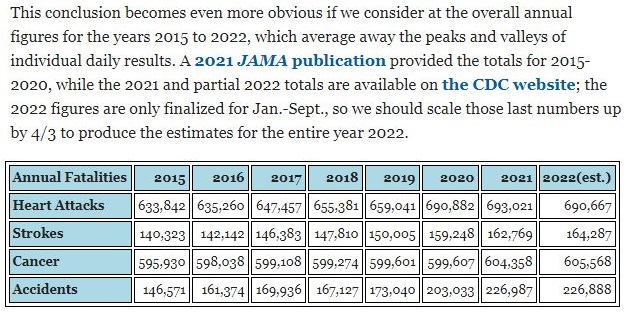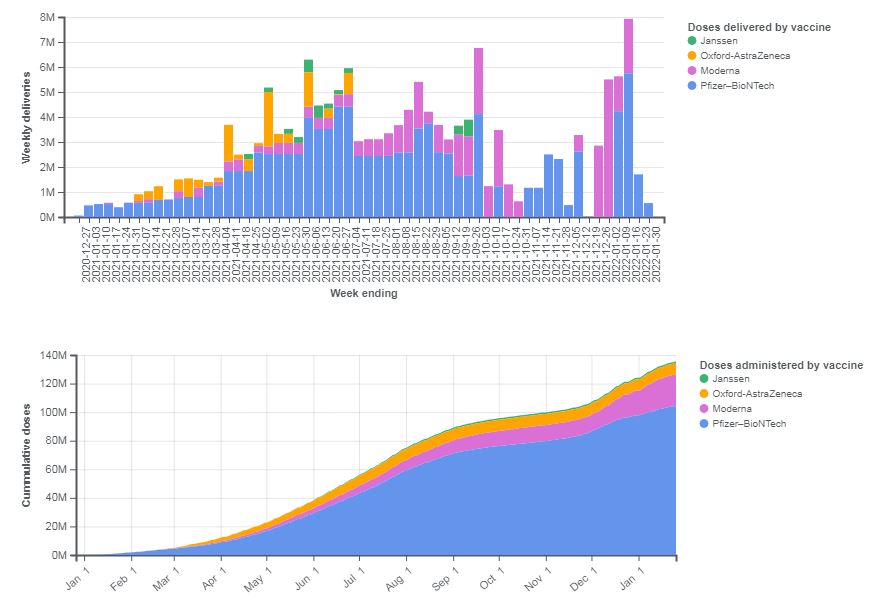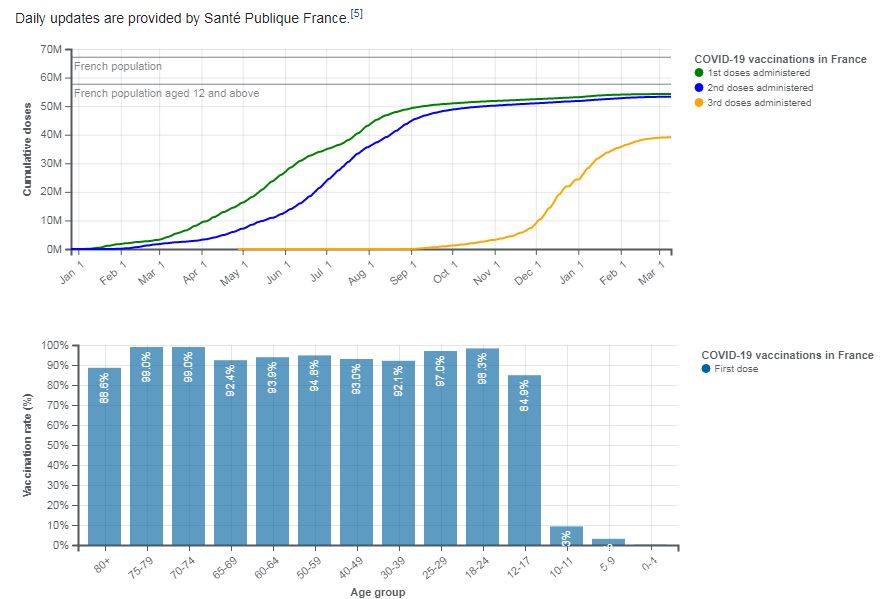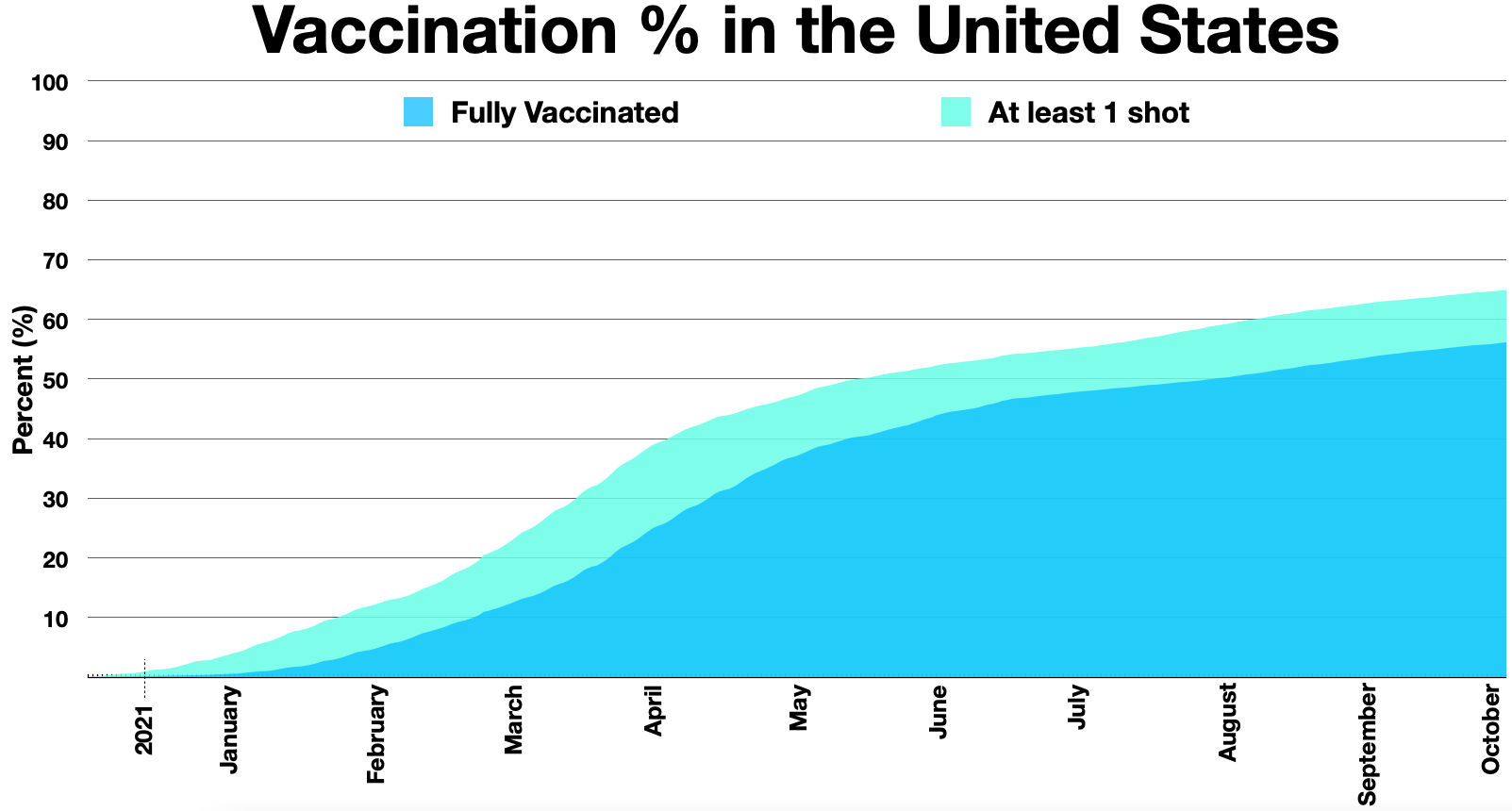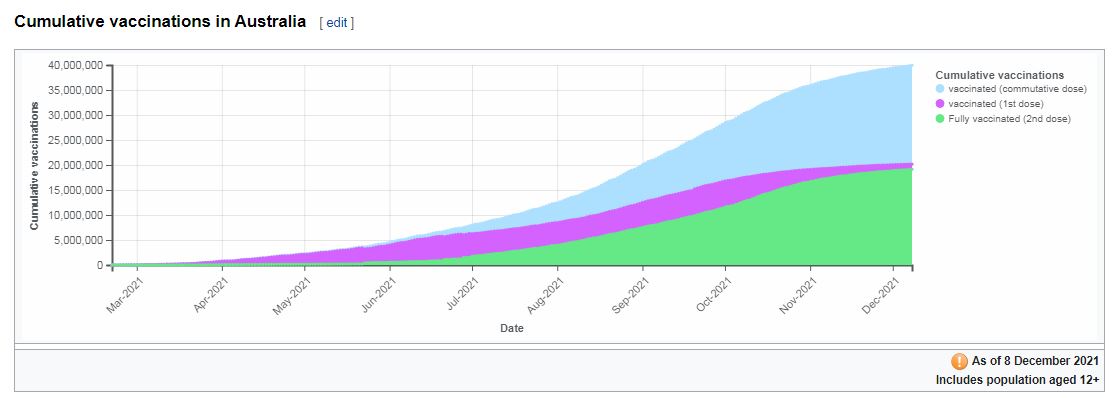What about this from Ron Unz?
Guest Post by Ron Unz
Many have declared that our alternative webzine features some of the most controversial content published anywhere on the Internet, notably including the explosive articles in my own lengthy American Pravda series.
Meanwhile, the global Covid epidemic has been the dominant issue of the last three years, generating more controversy than any other topic, at least prior to the outbreak of the Russia-Ukraine war.
Yet oddly enough, with one crucial exception—the origins of the virus—my own Covid views have been remarkably mainstream and humdrum, not too far from what I’ve seen in the pages of the New York Times and the Economist. This situation had naturally provoked outrage in many of our regular readers, who had often had been drawn to our website because they automatically rejected everything that the mainstream media promoted.
The conflict was especially severe with regard to the vaxxing controversy, and I’d guess that 95% of our readers vocal on the subject were anti-vaxxers, often extremely fervent ones. Nearly all of our regular writers and columnists who focused on that topic also fell into that same category, including Mike Whitney, Paul Craig Roberts, Linh Dinh, Gilad Atzmon, Israel Shamir, C.J. Hopkins, and several other contributors. But during my decades of political activism, I’ve frequently been in a small minority, sometimes standing almost alone on an important position, so I wasn’t particularly disturbed when this happened yet again in the pages of my own webzine, especially since I wasn’t particularly interested in the vaxxing issue.
Various other alt-writers or activists privately told me that they actually shared my views, but were very reluctant to say so lest they be swarmed and vilified by a horde of militant anti-vaxxers or even risk burning bridges with longtime friends and allies. Steve Sailer, our leading blogger, maintained his strongly pro-vaxx position, but only very rarely raised the issue since whenever he did so he would always be blasted by many of his own commenters. Vaxxing had become an ultra-touchy subject.
Refusing to conceal my views, in mid-2021 I published a long critique of the anti-vaxxing case, and every six months or so followed it up with another one. These functioned as powerful lightning rods, drawing vast waves of attacks by agitated anti-vaxxers, which eventually totaled close to 10,000 comments and perhaps a couple of million words. Indeed, some anti-vaxxers claimed that our lightly-moderated website had soon accumulated the largest body of anti-vaxxing content found anywhere on the Internet, thereby attracting anti-vaxxers from far and wide who sought detailed support for their views.
But all the mounting statistical evidence seemed to confirm my original skepticism, and each of my articles was somewhat more firm in drawing those conclusions than the preceding one.
- Are the Opponents of the Covid Injections “Anti-Vaxx Crackpots”?
Mike Whitney Interview with Ron Unz
Ron Unz • The Unz Review • August 1, 2021 • 9,000 Words • 1,681 Comments - Covid Deaths and Vaxxing Deaths
Ron Unz • The Unz Review • January 17, 2022 • 2,800 Words • 1,409 Comments - Vaxxing Conspiracies and 700,000 Rumble Views
Ron Unz • The Unz Review • July 18, 2022 • 2,800 Words • 941 Comments - Vaxxing Deaths or Covid Deaths?
Ron Unz • The Unz Review • January 2, 2023 • 3,300 Words • 1,113 Comments
That last article had noted that although anti-vaxxers argued that a huge wave of fatal heart attacks and strokes had been due to the mRNA vaccines, the American mortality statistics demonstrated that almost the entire rise had occurred during 2020 before the vaxxing began.
I summarized my findings in a few simple points:
- Vaxxing only began on December 14, 2020, so it would have had almost no public health impact during that year.
- Except for homicides and accidents, nearly all the major changes in American death rates occurred in 2020, so these must have been due to Covid.
- Except for homicides and accidents, non-Covid death rates showed almost no change in 2021 and 2022, so the vaccines probably had no impact one way or the other.
The Daily Sceptic is a leading alt-Covid website based in Britain, sharply critical of establishmentarian positions on Covid issues including vaxxing, and in late December I began corresponding with its editor Will Jones in connection with an excellent article he had published on Covid origin issues.
At one point, I happened to mention some New Zealand mortality statistics I’d seen somewhere, and he corrected them, directing me to the Human Mortality Database website, whose numbers he considered authoritative. Although the HMD had been launched in June 2020, I hadn’t previously heard of it and I immediately recognized it as an extremely useful source for such crucial information from dozens of mostly Western countries, conveniently aggregating, stratifying, and displaying official data that would otherwise remain buried on governmental websites. Given its apparent affiliation with both UC Berkeley and the Max Planck Institute plus its recommendation by the Daily Sceptic, I decided I could treat its numbers as quite reliable.
A excellent longtime commenter from Iceland calling himself “Niceland” had said he’d seen no indications of any significant numbers of vaxxing deaths in the mortality statistics of his own small, tightly-knit island republic, nor in those of a couple of other European countries whose data he’d tracked down. This made me curious about the broader international pattern, and the HMD website now gave me easy access to all of these statistics from a large number of countries, so I decided to investigate the issue more carefully.
From the beginning, alt-Covid activists have reasonably argued that cause of death is a somewhat ambiguous verdict, easily subject to official manipulation, and that considerable numbers of deaths might have been misattributed to Covid. Thus, they often point to total mortality rates as a much more solid metric to use, with these being the most reliable statistics for any country, especially the developed nations covered by the HMD website.
Furthermore, both the mainstream media and alt-Covid activists agree that Covid deaths were overwhelmingly concentrated among the elderly, with younger individuals having relatively little chance of dying from the disease. Therefore, the mortality statistics of the working-age population would be the place to seek evidence of vaxxing deaths, since any such signal would not be masked by the far larger number of ordinary Covid deaths.
The HMD website conveniently displayed mortality totals for those in the 15-64 working-age range, whose outright Covid deaths might be expected to be quite low, and this seemed the best category in which to explore the impact of vaxxing. The website showed excess deaths relative to a selected baseline, and I chose to use the average of the years 2015-2019 since those were available for all the countries listed.
The results were extremely enlightening. Although the non-elderly populations of almost all those countries had been very heavily dosed with Pfizer and Moderna mRNA vaccines, I found that many of them had actually experienced large “mortality deficits” during those years. Far fewer working-age individuals had died during 2021 and 2022 than would have been predicted in 2019.
This was true for roughly half of all the countries that had used Western-style mRNA vaccines, including France, Sweden, South Korea, Denmark, Belgium, and Finland. Much of the unexpectedly low mortality during those years may have been because the lockdowns and social distancing had reduced deaths from other sorts of contagious diseases and from traffic accidents. But regardless of the cause, if the massive vaccination drives were followed by noticeable reductions in mortality rates, it seemed unlikely that the vaxxing was causing substantial number of non-elderly deaths.
However, the United States was a very obvious exception to this pattern. We had experienced a large rise in working-age deaths beginning in 2020 and this continued into 2021 and 2022 although our vaxxing rates were generally below those of most of the other countries. We were not alone, with Canada, Chile, England, Australia, and a couple of other countries showing the same pattern of large excess deaths among the non-elderly, although none were quite as extreme as ours.
The common factor seemed to be the obesity rate, with America ranking highest in that measure and those other countries also mostly located towards the top of the international tables. Indeed, across all the countries in the HMD system, the correlation between the obesity rate and working-age average excess mortality rate was a moderately strong 0.56. This important result was a central conclusion of my resulting article.
I believed that the case I’d made was a very strong one, and I was pleasantly surprised to see that several of the more moderate and open-minded vaccine-skeptics seemed to agree, saying that my analysis was quite persuasive and even suggesting that I might be correct.
A couple of days before my article had been released, I’d appeared on Kevin Barrett’s Truth Jihad podcast for an hour-long show, and after I described the evidence I’d found, he thought I’d made a strong prima facie case.
Audio Player
Mike Whitney emphasized that I was conceding the broader theoretical arguments of the anti-vaxxing position even while claiming that the empirical evidence ultimately came out on the other side, and I generally agreed with him about that.
Tom Woods, a prominent libertarian figure and former Ron Paul advisor, had been a sharp critic of the vaccines, and he tweeted out his reaction to my article.
A couple of substackers squarely in the anti-vaxxing camp analyzed my quantitative claims and decided that I might be correct.
Several anti-vaxxers discussed my analysis on another substack thread, with some of them thinking I was probably correct and others wondering why none of the leading anti-vaxxers had yet responded to my provocative analysis.
In the past, prominent figures in the anti-vaxxing camp such as Steve Kirsch and Brett Weinstein had eagerly sought to debate opponents of their position, and in my article I had gladly offered to take up that challenge. Another anti-vaxxer was only partially convinced by my analysis, but she urged Kirsch to debate me and 74% of her readers in a poll took the same position.
Although Kirsch didn’t immediately mention my article, a few days after it ran he reiterated his support for a detailed analysis of vaxxing deaths by a British math professor named Norman Fenton, which had been widely promoted on Twitter. This prompted commenter Niceland to examine those claims and he attempted to refute them in a long comment.
Then on Friday, Kirsch contacted me, and we spent an hour discussing the topic the following day. He seemed quite surprised by some of my mortality statistics both for the US and other countries, and said he would carefully digest the information and then consider preparing a detailed response to my analysis.
Although many might find a strictly quantitative analysis persuasive, I think the evidence of working-age mortality rates for the various countries during 2019-2022 is especially compelling when examined visually, so I spent a couple of hours producing a complete set of those charts.
For example, here are the weekly mortality charts for France, Denmark, Finland, and Sweden, all having relatively low obesity rates, and they show mortality deficits each year. All of these countries were very heavily mRNA vaxxed during 2021, but there is no sign of any rise in their deaths after that vaxxing campaign began. (Clicking on the small images opens the full-size ones.)
France Working-Age Mortality Rates, 2019-2022
Denmark Working-Age Mortality Rates, 2019-2022
Finland Working-Age Mortality Rates, 2019-2022
Sweden Working-Age Mortality Rates, 2019-2022
France is by far the largest of these countries in population, and here are a couple of charts from Wikipedia showing the chronology and details of the French vaccination campaign, which was far heavier than that in America.
Unlike those previous countries, the US, Canada, Chile, and England all have much higher average obesity. Their charts show large excess mortality once the Covid epidemic began in 2020, but with no noticeable increase after the 2021 launch of the vaxxing campaign, and in some cases an apparent decrease in deaths, especially in 2022. No one looking at these weekly mortality charts would have ever suspected that there had been a massive 2021 vaccination drive.
USA Working-Age Mortality Rates, 2019-2022
Canadian Working-Age Mortality Rates, 2019-2022
Chile Working-Age Mortality Rates, 2019-2022
England and Wales Working-Age Mortality Rates, 2019-2022
Here is a chart from Wikipedia showing the trajectory of the American vaccination campaign:
The mortality charts for a few other countries are also worth considering.
A strict quarantine policy had allowed the island continent of Australia to almost entirely avoid Covid infections until it completed its vaccination campaign by the end of 2021. And despite the massive amount of vaxxing that year, mortality rates remained almost entirely flat, until the virus began circulating in early 2022, at which point excess deaths rose substantially. Australia has very high obesity, and apparently the vaccines were only moderately effective in protecting working-age Australians from the dangerous consequences of the virus, though the excess mortality was far less severe than that in pre-vaccinated Canada, whose obesity levels are similar.
Australia Working-Age Mortality Rates, 2019-2022
Meanwhile, vaxxing came very late to Bulgaria, only reaching significant portions of the population towards the end of 2021 and with less than one-third of the country fully vaccinated by February 2022; meanwhile Covid itself began circulating in late 2020, more than a year earlier. The resulting mortality charts show a series of three major spikes from late 2020 until early 2022, with very large excess deaths occurring prior to the beginning of the vaxxing campaign but then completely disappearing once the bulk of the population had been fully vaccinated.
Bulgaria Working-Age Mortality Rates, 2019-2022
South Korea was very heavily vaxxed during 2021, reaching the 86% level, roughly half with Pfizer and half with Oxford, and there was no noticeable change in the working-age mortality rates during this period. However, the country had also maintained a strict zero-Covid policy, preventing any significant number of infections, then finally relaxed that effort in March 2022, producing a huge spike in Covid cases and also a substantial but very temporary rise in working-age deaths, which soon fell back to normal levels. Thus, the changes in mortality were entirely associated with the rise in infections and had no connection to the vaccination drive.
South Korea Working-Age Mortality Rates, 2019-2022
Finally, Russia has reportedly suffered extremely high excess mortality during the Covid epidemic, and perhaps as a consequence the HMD website has not obtained access to its 2021 and 2022 statistics. But the huge spike that began in the last few months of 2020 certainly suggests how large those mortality rates may have grown over the next couple of years. Note that Russia has relied upon its own homegrown, non-mRNA vaccine, but which was anyway not yet available in large quantities at that point.
Russia Working-Age Mortality Rates, 2019-2020
All of these national mortality results seem very consistent with the hypothesis that the combination of Covid and obesity produces a large number of non-elderly deaths, but they show no sign of any significant number of deaths from the Covid vaccines. Furthermore, the obesity rate itself may actually be a proxy for a larger constellation of negative personal health characteristics.
I produced roughly 150 of these annual working-age mortality charts for the years 2019-2022, and they are all provided as links in the large table below, which also displays the obesity and vaccination rates for each country.
Those arguing that the Covid vaccines are highly dangerous regularly make the point that large vaccination drives have often been followed by substantial rises in the death rate. But although this is certainly true in some cases, the above mortality charts demonstrate that it is not true in many others.
As a further example, a recent article in the Daily Sceptic discussed a sharp rise in British deaths, analyzing the possible connection to Covid booster campaigns. According to the data presented, surges in deaths were sometimes correlated with boosting, they were sometimes uncorrelated, and they were sometimes anti-correlated, so the overall relationship was hardly clear.
Moreover, I think that even if there were usually a tight association, this sort of statistical relationship might perfectly illustrate the phrase “correlation does not imply causality.”
Consider individuals who regularly wear ballistic—“bullet proof”—vests. I’d assume that the overwhelming majority are either police officers or military troops in combat, and that the violent death rate in such professions is many times greater than that for the general public, given that well over 100,000 troops have already died over the last year in the Ukraine war alone. So there is surely a very high correlation between wearing body-armor and being killed by bullets or shrapnel, but no one would argue that such defensive equipment itself is actually increasing the likelihood of death or injury.
Similarly, the completion of a large Covid vaccination campaign has often prompted a national government to end some of its other public health restrictions such as lockdowns or a strict national quarantine. The vaccines are ineffective at preventing infection or transmission and only so-so in reducing the severity of the illness, so the result would normally be a large wave of new infections and some rise in the death rate. But this does not necessarily mean that the vaxxing itself was responsible for that negative outcome.
By contrast, I think a different sort of correlation calculation provides a far better means of weighing the relative role of vaxxing against other factors in determining the excess deaths in those various countries.
As we saw in the mortality charts displayed above, those countries with high excess mortality during 2020 also generally had high excess mortality during the following two years, and vice-versa. This pattern holds true for a large majority of all the countries whose statistics are available on the HMD website. Niceland emphasized this point in a lengthy comment, producing a chart showing the excess mortality rates for all the countries in the HMD system, as well as a separate chart that only includes the years of 2020 and 2022, in which the relationship becomes even more obvious.
But if the mortality totals of the pre-vaxxing year of 2020 are highly correlated with those of the post-vaxxing year of 2022, that indicates that the level of 2022 deaths was largely determined by the same factors, probably the interaction of Covid infections with local health characteristics, such as obesity levels and the strength of the public health system rather than having been influenced by the vaxxing. The stronger the correlation between the mortality levels of the pre-vaxxing and post-vaxxing years, the less possibility there exists for the vaxxing itself to have played any substantial role.
Niceland produced a scatterplot showing the relationship and found that the 2020-vs-2022 mortality correlation was a very strong 0.82, suggesting that the 2021 vaxxing campaign had minimal influence on the 2022 deaths.
Furthermore, three of the countries involved—Australia, New Zealand, and South Korea—are extreme outliers because their early, zero-Covid policies had prevented the disease from circulating in 2020, which severely distorts the comparison with 2022. If we exclude those countries, the remaining 2020/2022 mortality correlation becomes an extremely strong 0.86, remarkably high for any public health matter. This suggests that the massive vaxxing and boosting efforts of 2021 actually had very little impact upon working-age deaths during 2022.
Taken together all of these different analyses point toward the same conclusion: the mRNA vaccine campaigns were probably not responsible for any significant number of non-elderly deaths.
During a time of crisis, when only limited and fragmentary information is available, it is absolutely understandable that many concerned individuals might seize upon early indications of what seems to be a serious public health threat. When our medical and media establishments have repeatedly revealed themselves to be dishonest or unreliable, and they use emergency powers to push through a vaccination campaign of unprecedented scope relying upon an insufficiently tested new medical technology, only the gullible would fail to be deeply suspicious.
However, there also exists the serious risk that such early concerns built upon limited information may eventually harden into concrete and remain in place even if later data suggests that they were mistaken. An echo-chamber of the like-minded can develop that reinforces the fears of all its participants while insulating them from the evidence that would challenge their assumptions.
We should certainly still consider the possibility that the mRNA vaccines injected into billions of people worldwide may have serious, long-term adverse health consequences. But I think that two years of international mortality data have now demonstrated that most of the more extreme fears were overblown, and this should be admitted.
On a very practical level, when one’s opponents on a major political issue overwhelmingly control the commanding heights of government, media, and the medical establishments, it is especially important to avoid clinging to positions that may undermine one’s own credibility, which should be preserved for future battles. There seems little if any solid evidence that the Covid vaccines have caused any significant numbers of deaths, and maintaining otherwise may be self-defeating.
On the other hand, it is undeniable that the Covid virus itself has killed well over a million Americans and perhaps 18 million people worldwide, and its origins still remain shrouded in mystery. For decades, Prof. Jeffrey Sachs of Columbia University has been an academic figure of the highest mainstream respectability, holding numerous important international appointments. For the last two years, he served as chairman of the Lancet‘s Covid Commission, and in that role he has loudly denounced the government and the scientific establishment for their ongoing efforts to conceal the truth.
The establishment media would have no effective defense against the accusations coming from someone of Prof. Sachs’ international stature, and if the activists and outlets of the alt-Covid community began a concerted effort to publicize his explosive charges, the governmental cover-up might soon collapse, severely damaging the credibility of the media establishment that had helped to maintain it. Such an outcome might obviously also open the door to reconsideration of many other issues as well.
Meanwhile, I would also recommend my most recent article on the new efforts by the Daily Sceptic and other alt-Covid publications to uncover the origins of the Covid outbreak, as well as my entire long series of articles on that topic.
Much of this information is also available in several of my podcast video interviews from last February, which have been going very well on Rumble, picking up a total of more than 350,000 additional views so far this month and now approaching 3 million.
Kevin Barrett, FFWN • February 16, 2022 • 15m
Geopolitics & Empire • February 1, 2022 • 75m
Red Ice TV • February 3, 2022 • 130m

